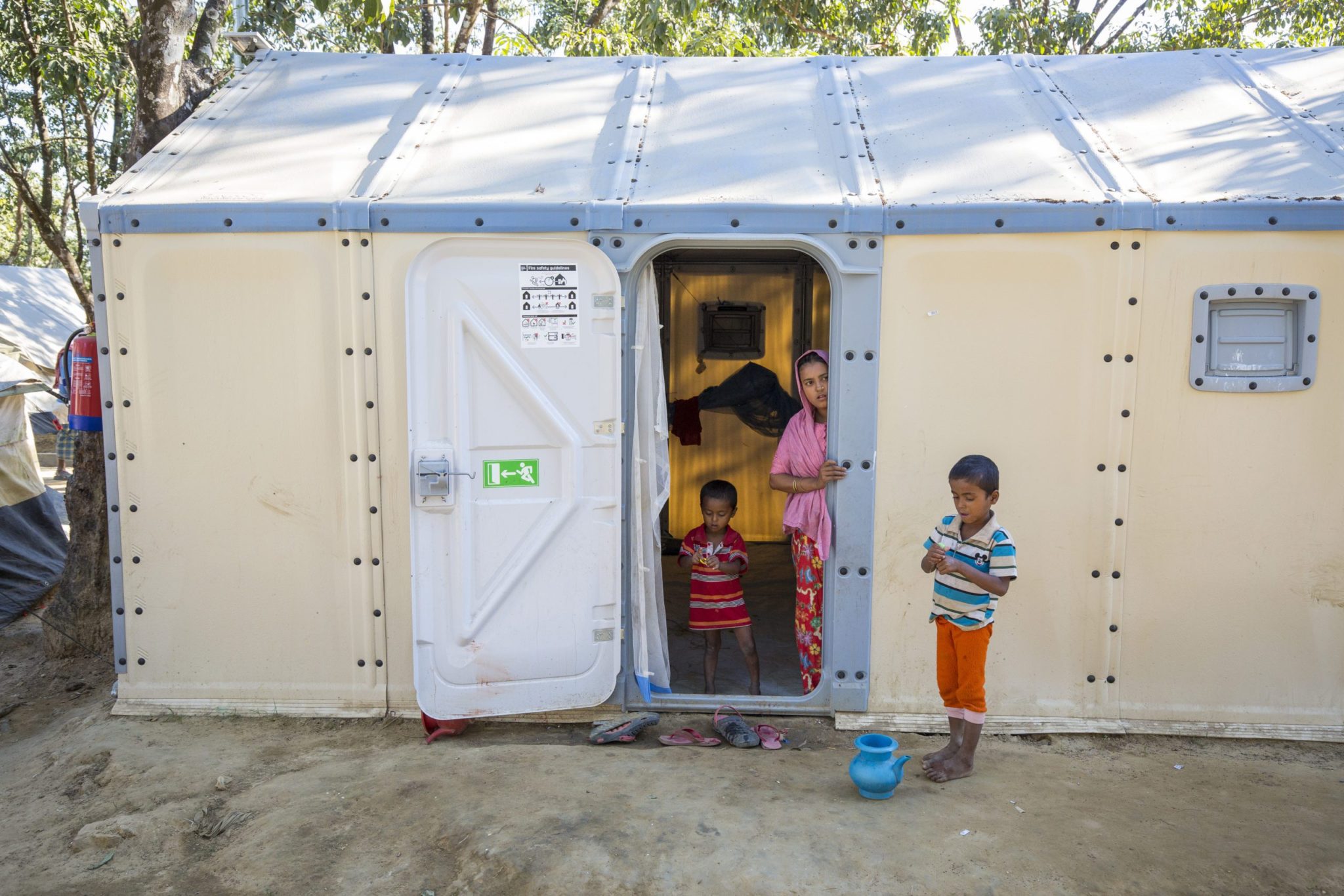Ensuring safety and access to services for Rohingya refugees in Bangladesh

The arrival of the Rohingya population fleeing violence in Myanmar has led to host countries and partner organizations making efforts to increase their humanitarian response. UNHCR in Bangladesh helps to provide adequate shelter, clean water, sanitation, alternative sustainable fuel, and protection for Rohingya refugees in Cox’s Bazar.
To support the national response in Bangladesh, UNHCR has implemented 528 Better Shelter Relief Housing Units (RHUs) to provide temporary shelters for the Rohingya refugee population. Some shelters were repurposed to serve as health clinics and other health infrastructure in the wake of the COVID-19 pandemic.
Read more about UNHCR’s efforts in Bangladesh here
A newly arrived Rohingya family from Myanmar, Mohamed, 25, Hajira Khatun, 22, Abu Bukkar Siddiq, 5, Mohammed Siddiq, 3, and Sadeka, 3 months, takes shelter in the UNHCR Transit Centre in Kutupalong camp, using the new Refugee Housing Units. ; With 900,000 Rohingya refugees in Bangladesh constituting more than 200,000 households, the settlements in Cox’s Bazar are among the largest in the world. Over a year since the largest wave of displacement in 2017, UNHCR continues to respond to the urgent and ongoing humanitarian needs in the camps in Cox’s Bazar, including Kutupalong, Nayapara and Ukhia. Helping provide adequate shelter, clean water, sanitation, alternative sustainable fuel, protection for vulnerable people and survivors of sexual and gender-based violence are among the priorities. Almost 700,000 Rohingya refugees fled Myanmar, seeking safety in Bangladesh in 2017.
Rohingya women (left to right) Ismat Ara, 20, Forida, 25, and Minara, 22, stand with their younger family members outside a housing unit in Kutupalong camp, Cox's Bazar. ; With 900,000 Rohingya refugees in Bangladesh constituting more than 200,000 households, the settlements in Cox’s Bazar are among the largest in the world. Over a year since the largest wave of displacement in 2017, UNHCR continues to respond to the urgent and ongoing humanitarian needs in the camps in Cox’s Bazar, including Kutupalong, Nayapara and Ukhia. Helping provide adequate shelter, clean water, sanitation, alternative sustainable fuel, protection for vulnerable people and survivors of sexual and gender-based violence are among the priorities. Almost 700,000 Rohingya refugees fled Myanmar, seeking safety in Bangladesh in 2017.
Children from newly arrived Rohingya families from Myanmar take shelter in the UNHCR Transit Centre in Kutupalong camp, using the new Refugee Housing Units. ; With 900,000 Rohingya refugees in Bangladesh constituting more than 200,000 households, the settlements in Cox’s Bazar are among the largest in the world. Over a year since the largest wave of displacement in 2017, UNHCR continues to respond to the urgent and ongoing humanitarian needs in the camps in Cox’s Bazar, including Kutupalong, Nayapara and Ukhia. Helping provide adequate shelter, clean water, sanitation, alternative sustainable fuel, protection for vulnerable people and survivors of sexual and gender-based violence are among the priorities. Almost 700,000 Rohingya refugees fled Myanmar, seeking safety in Bangladesh in 2017.
Children from newly arrived Rohingya families from Myanmar take shelter in the UNHCR Transit Centre in Kutupalong camp, using the new Refugee Housing Units. ; With 900,000 Rohingya refugees in Bangladesh constituting more than 200,000 households, the settlements in Cox’s Bazar are among the largest in the world. Over a year since the largest wave of displacement in 2017, UNHCR continues to respond to the urgent and ongoing humanitarian needs in the camps in Cox’s Bazar, including Kutupalong, Nayapara and Ukhia. Helping provide adequate shelter, clean water, sanitation, alternative sustainable fuel, protection for vulnerable people and survivors of sexual and gender-based violence are among the priorities. Almost 700,000 Rohingya refugees fled Myanmar, seeking safety in Bangladesh in 2017.
Children from newly arrived Rohingya families from Myanmar take shelter in the UNHCR Transit Centre in Kutupalong camp, using the new Refugee Housing Units. ; With 900,000 Rohingya refugees in Bangladesh constituting more than 200,000 households, the settlements in Cox’s Bazar are among the largest in the world. Over a year since the largest wave of displacement in 2017, UNHCR continues to respond to the urgent and ongoing humanitarian needs in the camps in Cox’s Bazar, including Kutupalong, Nayapara and Ukhia. Helping provide adequate shelter, clean water, sanitation, alternative sustainable fuel, protection for vulnerable people and survivors of sexual and gender-based violence are among the priorities. Almost 700,000 Rohingya refugees fled Myanmar, seeking safety in Bangladesh in 2017.
Children from newly arrived Rohingya families from Myanmar take shelter in the UNHCR Transit Centre in Kutupalong camp, using the new Refugee Housing Units. ; With 900,000 Rohingya refugees in Bangladesh constituting more than 200,000 households, the settlements in Cox’s Bazar are among the largest in the world. Over a year since the largest wave of displacement in 2017, UNHCR continues to respond to the urgent and ongoing humanitarian needs in the camps in Cox’s Bazar, including Kutupalong, Nayapara and Ukhia. Helping provide adequate shelter, clean water, sanitation, alternative sustainable fuel, protection for vulnerable people and survivors of sexual and gender-based violence are among the priorities. Almost 700,000 Rohingya refugees fled Myanmar, seeking safety in Bangladesh in 2017.



